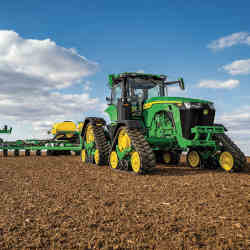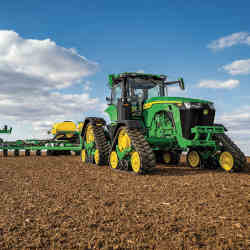
Step inside the cab of the John Deere 8RX Tractor, and you may be surprised at how it resembles an airplane cockpit, with systems and maps that produce lots of data (and a comfortable seat, to boot). Attached to that cab is a planter equipped with 300 sensors and 140 controllers that methodically and precisely deliver seed to the soil in near-perfect rows.
Farming is often an inexact science. As global demands on agriculture continue to grow, Deere and others are looking to change that with precision agriculture technology.
The human population of the world is expected to climb from an estimated 7.8 billion in 2020 to 9.7 billion by 2050 and 11.2 billion by 2100, according to the United Nations World Population Prospects reports. As the population grows, demands on farmers also are growing; they are tasked with feeding the world, but with increasingly less land and fewer resources, while facing the impacts of climate change.
Companies like John Deere and startup EarthSense are looking to address those challenges. Increasingly, robotics, GPS controls, computer vision, and sensors embedded with machine learning are being added to farm equipment to do things like plant seeds, identify weeds so herbicide can be sprayed in the right places, and even pick strawberries.
This is expected to advance the deployment of smart and autonomous farm machinery, according to market research firm McKinsey. "Increasing the autonomy of machinery through better connectivity could create $50 billion to $60 billion of additional value by 2030," the firm said.
In 2018, some 10% to 15% of U.S. farmers were using Internet of Things (IoT) systems across 3.1 billion acres and 250,000 farms, and were collectively spending about $960 million.
Almost 230 million acres were covered by John Deere technology alone in 2020 across more than 100 countries–a 53% increase since August 2019, according to the company.
The John Deere equipment, moving through a field at 10 mph, can plant 100 seeds per second. EarthSense's TerraSentia robot is designed to incorporate machine vision and machine learning-based analytics to optimize the yield of farms well beyond what humans alone have been able to accomplish.
"Our customers are faced with a tremendous amount of variability," says Nancy Post, director of embedded software and solutions at John Deere. "They are constantly barraged with things not under their control,'' including changing weather and labor shortages. "We want them to be able to produce more faster and with less."
Seeds and fertilizer need to be placed at the right depth and spacing to optimize plant growth, before closing up the soil. The seeds need to receive sufficient light, but still be deep enough so they can grow and flourish, Post says. In fact, two identical seeds can produce different results if they are not planted the same way.
Planting can now be done in less time with the right equipment, and the right data. "To have this very precise system takes a tremendous amount of data," which is gathered in the field, sent to the cloud where it is analyzed, and sent back to optimize production, Post says. "Now [farmers are] planting at almost twice the speed than in the past and more precisely to optimize that seed growth and output at the end of the year.''
In the connected cabs of those tractors, where farmers may spend 14 to 16 hours a day, they can monitor systems, view maps, and obtain predictive maintenance alerts so they don't have to wait for a problem to occur, according to Post.
John Deere incorporates a number of robotic processes, using computer vision and artificial intelligence inside the machines where the farmer can't be, to monitor the quality and condition of harvested kernels of grain, the company said.
Chinmay Soman, co-founder and CEO of EarthSense, says that growing up in India, he witnessed the issues farmers faced. "Tens of thousands of farmers were committing suicide because the economics" were not good, he recalls. "I was really moved and shaken by this major crisis … and spent time figuring out what I could do to help."
Soman spoke with hundreds of farmers, crop scientists, and others in the industry, and learned that while they have had access to satellite data since the 1970s, "one of biggest problems is all of that data doesn't really tell them what problems are happening on their field."
In 2017, EarthSense introduced TerraSentia to provide visibility into issues close to the ground like disease, damage, and lack of water or fertilizer. "By the time they can be seen from air, it's usually too late to do anything about it,'' Soman explains.
The autonomous robot is equipped with machine learning and stabilized high-definition cameras. It traverses fields and provides insights from "under the canopy data," obtained from the area below the top layer of a plant's leaves, Soman says.
"When you look at a farm from the air, you will only be able to see the top 5% of the plant; most of it will be hidden from view." Looking at the plant from the under-the-canopy vantage point provides the opportunity to see specific colors and the shape of a splotch on a leaf, which indicates the type of insect attacking it, Soman says.
Crop breeders spend vast amounts of time figuring out which variety of corn will be most effective for a particular geographic region. They send people to the fields to measure plants by hand to see which variety is doing well despite drought or other adverse conditions, he says. TerraSentia automates the process of evaluating different plant varieties to identify which work best.
EarthSense found that automating under-canopy data collection is "a completely open challenge." It works with the companies that create the seeds for farmers. In 202o, the company sent close to 50 robots to customers to collect data, primarily on corn, soybean, cotton, and wheat crops.
Soman says as the company scales up production, the cost of the TerraSentia will "easily come down to below $5,000" from the current price of $25,000. Each robot can plant an 80-acre field in just a couple of hours, he adds.
Esther Shein is a freelance technology and business writer based in the Boston area.




Join the Discussion (0)
Become a Member or Sign In to Post a Comment